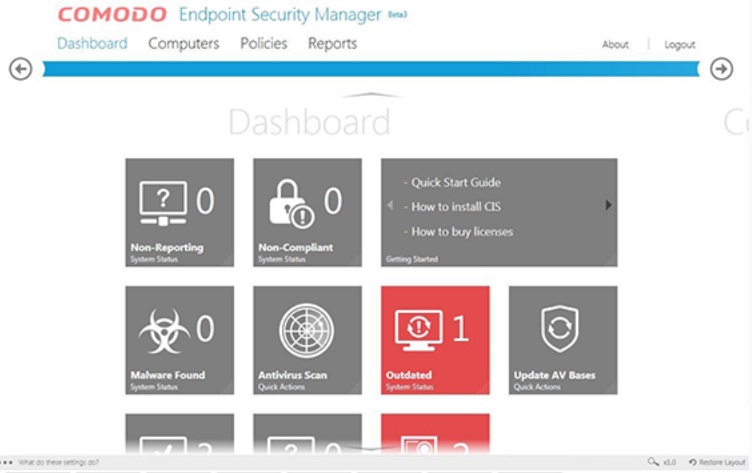Endpoint Security Manager – Comodo
Comodo Endpoint Security Manager enables single-point control of Comodo’s 7-layered security platform for ensuring complete protection of endpoints against malware and advanced persistent threats.
What is Endpoint Security?
Endpoint security is a compliance-based network security management that requires all remote devices in the network to follow the policy laid out in the compliance in order to access allocated network resources. In a client/server model, an endpoint security vendor administers the security protocols of a corporate network from a remote location to ensure that devices requesting access to the network comply with the policies.
Endpoint security systems work on a client/server model in which a centrally managed server or gateway hosts the security program and an accompanying client program is installed on each network device. In a software-as-a-service (SaaS) delivery model, the host server and its security programs are maintained remotely by the vendor. In either delivery model, when a client attempts to log onto the network, the server program validates user credentials and scans the device to make sure that it complies with defined corporate security policies before allowing access to the network.
7-Layer Endpoint Security Platform
– Containment with auto-sandboxing – All unrecognized processes and applications are auto-sandboxed to run in a restricted environment.
– Web URL Filtering – Advanced interface to create rules as required – user-specific, sweeping, or as granular as desired.
– Comodo Firewall – Offers high-level security against inbound and outbound threats, stealths computer’s ports, manages network connections, and blocks confidential data transmission by malicious software.
– Comodo Antivirus – Features multiple technology-based automatic detection, cleansing and quarantining of suspicious files to eliminate malware and viruses.
– File Lookup Services (FLS) – Cloud-based instant analysis of unknown files that checks file reputation against Comodo’s master whitelist and blacklists.
– Host Intrusion Protection System (HIPS) – monitors important operating system activities to ensure protection against malware intrusion.
– Viruscope (Behavior Analysis) – Behavior of all processes are monitored for potential harmful action.
Comodo Endpoint Security Manager (ESM) software brings 7 layers of defense – antivirus, firewall, web URL filtering, host intrusion prevention, auto-sandbox (containment), file reputation and viruscope (behavioral analysis) – together under a single offering for customers of all sizes, to protect them from both known and unknown threats.
Comodo ESM Checks All the Boxes…
Whether deployed as a complete security suite or by using the sandbox as a standalone to fortify existing AV solutions, Comodo Endpoint Security Manager offers unrivalled endpoint protection for Microsoft Windows servers, desktops, laptops and tablets.
The full Comodo Endpoint Security suite brings 7 layers of protection to the point of impact – the endpoint environment. Its disruptive auto-sandbox technology eliminates malware outbreaks and operating system contamination by automatically running untrusted/unknown process in a virtual environment within the existing system and with low system usage requirements. This makes Comodo’s endpoint protection the only managed anti-malware solution that can offer a $5,000 limited warranty against infection.
The Comodo Endpoint Security Manager dashboard gives administrators panoramic insight and control over all aspects of endpoint protection and management. Its streamlined interface displays 14 critical metrics about each machine, facilitating rapid alerting and remediation of issues. Administrators can also terminate endpoint processes, stop or start services, uninstall applications and delete unwanted files – all without causing interference to the end-user.
Comodo Endpoint Security Manager allows you to control and centrally manage endpoint protection through the application of operational templates or policies. Any deviation from these policies causes Comodo Endpoint Security Manager to automatically reapply the assigned policy or alert the administrator if it is unable to do so.
Comodo’s endpoint protection also provides administrators with the ability to centrally manage endpoint system resources. Administrators can define operational thresholds for CPU usage, RAM usage, network usage and available storage. Should the thresholds be exceeded, Comodo Endpoint Security Manager will alert the administrator through the dashboard and via email notification.
Additional policy configurations include power management such as screen-locking or drive-locking. Your Green initiatives are further enhanced through system-standby and system-hibernation scheduling. Comodo’s endpoint protection also offers options for disabling USB mass-storage devices, optical devices and even floppy drives.
Features Comodo Endpoint Security Manager
More Control, Less Worry
One-of-a-kind containment technology automatically sandboxes unknown malware in a ‘Virtual Desktop’.
Manage with Ease
Single-point management of servers and endpoints – workstations, laptops, smartphones and associated applications.
Engage in Best Practices
Multiple technologies combining containment with auto-sandboxing, web URL filtering, antivirus, firewall, cloud-based FLS, process behavior analysis and HIPS to protect each endpoint.
Save Time
Centralized system management to monitor and control processes, services and applications at endpoints.
Simplify Administration
Easy administration through ‘pull’ and ‘push’ deployment.
Interact Remotely
Ability to communicate with remote endpoints and users to provide remote assistance.
Lower Response Time
Faster response time to new and emerging threats.
Deepen Understanding
Definition of specific security configurations on the granular-level for endpoints within and outside the VPN made possible by location-aware policies.
Go Green
Integrated power management through advanced Wake-on-LAN enabled systems.
Keep System Requirements Low
Low system requirements allows installation of the product even on non-dedicated Windows servers and Pcs.
Gain Insights
At-a-glance snapshot of security settings through intuitive graphical user interface.
F.A.Q
What protection does Endpoint Security offer?
Comodo Endpoint Security offers 360° protection against internal and external threats by consolidating multiple, cutting edge security technologies in a single, easily installed solution. These include:
– Comodo’s powerful antivirus and award-winning firewall solutions
– Comodo’s innovative Host Intrusion Prevention System which prohibits untrusted executables from tampering with other processes and files
– Auto-Sandbox™ technology which automatically runs untrusted applications in a contained, isolated environment so they cannot damage the underlying operating system or access user files
– Integrated ‘File Reputation’ system uses behavior analysis to help determine the trustworthiness of unrecognized files – all without interrupting the end-user
Comodo is so confident that we can protect endpoints against infection that we are the only vendor to offer a $5,000 Limited Virus-Free Warranty .
How much system resource is consumed on the endpoint?
On idle, the entire 5-in-1 suite only consumes 7.5MB RAM and doesn’t register any CPU usage in Windows Task Manager.
How do I manage endpoints using Comodo Endpoint Security?
Endpoint can be administered via a list, tile or panoramic display interfaces.
Can the management server be run from a virtual server?
Yes.
Can I manage virtual machines?
Yes. ESM can manage full virtualized machines or virtual machines cloned from templates (requires sys prep utility to be run on master template first).
Where do I deploy the endpoint protection server?
The endpoint protection server can be installed on any supported Microsoft Windows operating systems running on a private cloud server, public cloud server or on-premises server.
I manage endpoints in multiple locations, how do I use Comodo ESM?
You can manage all your endpoints from a single endpoint protection server. Alternatively, you can use Comodo ESM ‘Dependent Servers’ function so that each site has its own endpoint protection server which you can control from an upstream endpoint protection server.
How do I deploy to my endpoints?
Comodo ESM will auto-discover any endpoints in your Active Directory/LDAP containers. Alternatively, you can use the wizards to ‘push’ the ESM agents to the systems you want managed. You can ‘push’ deploy to Active Directory OUs, Microsoft workgroups, single IP addresses or an IP address range. You can also download and save the Windows, Mac or Linux management agents to a shared folder, then use login scripts or Group Policy to ‘pull’ deploy to your systems.
Is alerting/reporting done on a schedule?
No. Comodo’s endpoint protection alerting takes place in real-time.
How do I know when something is wrong?
There are several ways that ESM alerts an administrator.
– The endpoints tile icon will change color to indicate an infection has been found, the signature database is out of date, the endpoint is not policy compliant or system resource usage has exceeded pre-defined thresholds.
– The numbers in the information bar’s heads-up display will increase.
– Comodo Endpoint Security Manager will send you a notification email for any event that you specify.
How are virus database updates received and how are they pushed out?
Virus database updates aren’t pushed; instead they are pulled by the endpoint according to the schedule you have set for them. Updates can be received from the Internet or from the ESM server acting as a caching proxy. You can choose to use either (or both) as part of the post-deployment policy configuration. Administrators can also update selected endpoints using the ‘Update’ button in the administrative interface or on the endpoint’s ‘Properties’ tab.
Can I enable and disable individual components?
Yes. You can choose which components to install (AV/Firewall/Sandbox) during the initial setup or you may re-configure the components at any time thereafter.
Can I configure Endpoint Security Manager to use an existing database server?
Yes. Comodo’s endpoint protection can use its embedded Microsoft SQL Express 2012 edition or can be configured to use an existing instance of Microsoft SQL 2005 or later (Express, Standard or Enterprise).
System Requirements
Endpoint Protection Central Service computer – The host running the Endpoint Security Manager Server software
Hardware requirements
– Dual-Core 1.8 GHz processor or better
– 2 GB RAM (4GB recommended)
– 15 GB free disk space if using SQL Express 2008/2012
Software requirements
Operating system
a) Microsoft Windows Server family:
– Windows 2003 Server (SP2 or higher) x86 and x64 editions
– Windows 2003 Small Business Server
– Windows 2003 Small Business Server R2
– Windows 2008 Server (SP2 or higher) x86 and x64 editions
– Windows 2008 Small Business Server
– Windows 2008 Server R2
– Windows 2011 Small Business Server
– Windows 2012 Server
b) Microsoft Windows client family:
– Windows Vista (SP1 or higher) x86 and x64 editions
– Windows 7 x86 and x64 editions
– Windows 8 x86 and x64 editions
Other supporting software (will be installed automatically if not present)
– Microsoft .NET Framework 4.0
– Microsoft ReportViewer 2010 SP1
– Microsoft SQL Server 2012 Express LocalDB
Endpoint Protection Administrative Console computer – The computer that will run the management interface (this computer may also be the Central Service PC)
Hardware requirements
Sufficient to run any of the browsers listed below.
– Microsoft Internet Explorer 10.0 or higher
– Mozilla Firefox 21.0 or higher
– Google Chrome 27.0 or higher
– Comodo Dragon 27.0 or higher
– Opera 12.x or higher
– Safari 5 or higher
– Maxthon Cloud Browser 4.x or higher
Other supporting software (will be installed automatically if not present)
– Microsoft Silverlight 5.1
Display
– Minimum 1024×768 display with windowed browser
– Optional touch capable display interface and operating system
Comodo ESM Endpoints – Managed endpoints that will run Comodo Endpoint Security/Comodo Antivirus for Servers and host the endpoint protection agent
Hardware requirements
– 1.2 GHz processor or better
– 512 MB RAM (1GB recommended)
– 420 MB free hard drive space
Software requirements
Operating system
a) Microsoft Windows client family:
– Windows XP (SP3 or higher) x86
– Windows Vista (SP1 or higher) x86 and x64 editions
– Windows 7 x86 and x64 editions
– Windows 8 x86 and x64 editions
b) Microsoft Windows server family:
– Windows 2003 Server (SP2 or higher) x86 and x64 editions
– Windows 2003 Small Business Server
– Windows 2003 Small Business Server R2
– Windows 2008 Server (SP2 or higher) x86 and x64 editions
– Windows 2008 Small Business Server
– Windows 2008 Server R2
– Windows 2011 Small Business Server
– Windows 2012 Server
c) Apple Mac OS X® client family:
– Mac OS X 10.10
– Mac OS X 10.6.8
d) Debian Linux .deb family:
– Debian x86 and x64 editions
– Ubuntu x86 and x64 editions
Licensing & Pricing
Comodo Endpoint Security Manager licenses are offered in 3 ways:
Free Trials
Try Endpoint Security Manager free of charge. Start Free Trial
Basic Subscription
Unparalleled security for network endpoints. Get Protection Now
Premium subscription
With professional services and support For Enterprises.
Get an Easy Quote
For questions, demos, quotations or additional information please click here to contact us
Kata Kunci Terkait :
Comodo Endpoint Security Manager, jual Comodo Endpoint Security Manager, beli Comodo Endpoint Security Manager, fitur Comodo Endpoint Security Manager





